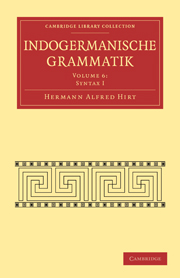VII - Das Verbum finitum
Published online by Cambridge University Press: 05 August 2011
Summary
Die Genera Verbi. Vorbemerkung. Als auffallende Erscheinung beim Verbum treten uns in den klassischen Sprachen die drei Genera Verbi, Aktivum, Medium oder Deponens und Passivum entgegen, wobei einerseits die aktive Bedeutung durch aktive und mediale Endungen, anderseits die passive durch mediale, aber auch aktive (gr. Aor. Pass. ἐλύϑην) ausgedrückt wird. Auch das Indische kennt die Verschiedenheit von Aktivum und Deponens, gebraucht aber zur Bezeichnung des Passivs im Präsens eine Bildung mit besonderem Suffix und medialen Endungen. Das Gotische verwendet die Medialformen passivisch, besitzt aber auCerdem aktive Formen mit besonderem Suffix, um das Passiv auszudrücken.
Während uns die Unterscheidung von Aktiv und Passiv ganz naturlich erscheint, mangelt uns ein Gefühl für das Deponens, und aucb den alten Grammatikern hat dies gefehlt, wie Wackernagel 1, 120 zeigt. Der Ausdruck deponens weist darauf hin. Er will sagen, derartige Verben hätten die passive Bedeutung, die man als ursprünglich ansah, abgelegt, während Medium = gr. μεσóτης ‘die Mitte’ ein farbloser Ausdruck ist gegenüber ἐνέρεγια ‘Tätigkeit’ und πάϑoς ‘Leiden’.
Diese drei Genera Verbi gehen aber in den romanischen Sprachen verloren, wie sie in andern Sprachen, dem Germ. Slaw. Lit., schon vorgeschichtlich verlorengegangen sind. Sie werden also wohl nicht durchaus notwendig gewesen sein. Ganz gewiß nicht. Sie waren ein Ballast.
Aktivum und Deponens. Man hat sich heiß bemüht, die ursprüngliche Bedeutung der beiden Genera Aktivum und Deponens klarzustellen, ohne daß man zu einer befriedigenden Erkenntnis gelangt wäre. Die passive Bedeutung soil, wie man annahm, sekundär sein, und sich erst vor unsern Augen entwickelt haben.
- Type
- Chapter
- Information
- Indogermanische Grammatik , pp. 197 - 292Publisher: Cambridge University PressPrint publication year: 2009First published in: 1934



